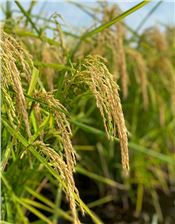Prices Move Higher After USDA Report Cuts Rice, Soybean Acres

Prices for long-grain rice, cotton and soybeans moved higher Monday following the release of the National Agricultural Statistics Service’s “Crop Production” report.
Division of Agriculture photo
MARY HIGHTOWER
JONESBORO, ARKANSAS
Prices for long-grain rice, cotton and soybeans moved higher Monday following the release of the National Agricultural Statistics Service’s “Crop Production” report.
The NASS report included findings from the Farm Service Agency’s acreage reporting. Based largely on those FSA figures, there was a 100,000-acre reduction this month in U.S. long-grain harvested acres and a 580,000-acre reduction in soybeans.
NASS is part of the U.S. Department of Agriculture.
The NASS report also lowered the U.S. average rice yield by 41 pounds per acre in September to 7,586 pounds. Arkansas' total rice yield was reduced by 50 pounds per acre to 7,500. This is down from last year's 7,630 pounds.
“One of the most eye-catching adjustments on Monday was to U.S. long- grain production,” said Scott Stiles, extension economist for the University of Arkansas System Division of Agriculture, said on Monday.
“It was lowered 8 million hundredweight this month on a combination of lower acres and yield.”
The market reaction has been positive following the report,” he said.
“November rice closed about 11 cents higher on Monday at $17.70 per hundredweight.”
Jarrod Hardke, extension rice agronomist for the Division of Agriculture, said the new numbers are within projections.
“The lowering of acres still keeps things around the 1.1 million acre mark we were projecting,” he said.
“As for yield, the reduction now puts the projections within the range we expected, which was similar to the few years preceding the record yields of 2021,” he said. “Still very good yield potential but not going to challenge last year’s yield record. Given that we still have a large amount of the crop to harvest, much remains to be seen on where the yields really are.”
Reduced demand
On the U.S. long-grain balance sheet, there were also some reductions to demand. Domestic use was lowered 3 million hundredweight and exports trimmed by 2 million.
“The net result was a 2.8 million reduction in ending stocks to a total of 20.9 million hundredweight – the lowest since 2019,” Stiles said. “The long-grain average producer price for the ’22-‘23 marketing year is projected to be a record $7.43 per bushel.”
Adverse weather in rice-growing regions of China and India have also made an impact.
Stiles said Monday’s report “adds momentum to last week's gains in the rice market. Last week India announced some restriction on rice exports, which gave the rice market a lift.”
“Today, USDA reduced rice production in both India and China by a combined 4 million metric tons. India's export projection was reduced by 2 million tons,” Stiles said.
Soybeans
For soybeans, U.S. harvested acres were reduced 580,000 this month and the U.S. yield was reduced by 1.4 bushels per acre to 50.5. Total production was lowered 153 million bushels to 4.378 billion.
Stiles said most of the reduction was due to excessive heat and dry conditions in the western Cornbelt states.
“The biggest bean yield reductions were pretty much in the corridor from Texas to South Dakota – the area most impacted by drought this year.”
U.S. soybean stocks are projected to be tight at 200 million bushels in the ’22-’23 marketing year. USDA projects the average producer price for the 2022 crop to be $14.35, the second highest on record and the highest since 2012.
Cotton
As Arkansas approaches cotton harvest, the state saw a bump in the number of projected harvested acres from 490,000 to 630,000.
“Overall, the U.S. harvested acres were increased 747,000,” Stiles said. “Most of that came from increases in Texas, Arkansas and Georgia.”
That’s a significant increase from the August USDA report that had the total U.S. cotton acres at their lowest since the Civil War. The difference is attributed to information reported by farmers to FSA.
Arkansas' yield was increased to 1,219 pounds, up from 1,195 last month, which was below last year's record of 1,248. The U.S. yield was lowered 3 pounds to 843 per acre.
The supply/demand numbers from USDA were not bullish. With the increase in harvested acres, production was increased by 1.26 million bales to 13.83 million.
Ending stocks were increased by 900,000 bales to 2.7 million. Stocks are still historically tight and the lowest since 2013.
“USDA projects a record price of 96 cents for the '22 crop,” Stiles said. “December futures closed 87 points higher today at $1.0571.”
Bill Robertson, extension cotton agronomist for the Division of Agriculture, said the report had one surprise.
“I was expecting the increase in cotton acres,” he said. “I was not expecting the lint yield increase.
“We’ve seen some fields getting close to harvest, but none harvested,” he said. “These fields are looking good – not as good as last year but pretty good.”
The good-looking fields were those that saw timely irrigation, he said.
Over the last few years, defoliation has only picked up steam in mid- September, Robertson said. This year appears to be following that trend.
“The high-pressure system that is sitting on top of us now and for the next week or so will help get things rolling,” he said. ∆
MARY HIGHTOWER: University of Arkansas